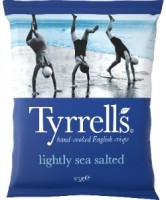Food Trends feature
FEATURE: Why pricing is key to helping you sell on-trend dishes

Promotional content
Better snacks increases spend
Bagged snacks represent a critical opportunity for pubs and bars to drive their sales, increasing spend and tempting customers on drinks-only visits to trade up.
Some 52% of customers[1] purchase snacks on impulse and pubs and bars can turn these impulse opportunities into incremental sales by stocking a range of best-selling snacks that are recognisable and trusted. Ensuring a core range is available and, importantly, visible to consumers is key to making the most of this opportunity.
Familiar brands that are matched to your customer base are extremely important in driving snacks sales and we have one of the most versatile portfolios on the market. Tyrrells is an award winning hand cooked English crisp brand, while KP Nuts is the UK’s number one nut brand with 5 packs sold every minute in bars[2].
Hula Hoops is ideal for a family audience, while popchips and POM-BEAR are brilliantly placed to capitalise on healthy snacking trends.
KP Snacks has also invested in providing simple and relevant advice via its ‘Behind the Bar’ platform that offers category support and guidance to get snack sales moving for all types of outlets. This includes support and advice on what to stock, point of sale materials and merchandising recommendations. Pubs and bars that want help getting snacks sales moving can contact KP Snacks at gurone@xcfanpxf.pbz.
[1] CGA Pub snacking habits survey April 2020
[2] Kantar OOH Pubs & Bars Spend 52 w/e 29.12.19
Three to watch
Tasneem Alonzo, joint managing director of food supplier EHL Ingredients, picks her top three pub food trends for the year ahead.
Multi-ethnic
We’re seeing a melting pot of fusion foods. Think tikka tacos, sriracha hot dogs, harissa frittatas, cheeseburger pierogies, jollof rice with burritos, tabil sprinkled on pizzas, melekesha on flatbreads, and curried Scotch eggs. There’s a clear opportunity for pubs get creative – or bring in a food truck or foodie night. The cuisines we’re expecting to surge in popularity are Korean barbecue, Brazilian, Levantine, west African and Greek.
Planet-friendly
People are turning to local, seasonal foods with as little carbon footprint and environmental impact as possible. Expect to see a rise in the popularity of foods from local farms and producers with few food miles. Consumers are also aware of the potential health benefits of certain ingredients and are welcoming natural, functional foods and ingredients with micronutrients.
Comfort and convenience
Sharing foods, grazing boards, hand-held bites and casual concepts are driving dining experiences. They are easy to eat, great to share, suitable for dipping and appealing to the Instagram generation. Soup is also surging, boosted by pulses and grains for a hearty, filling, cost-effective meal while moqueca (Brazilian seafood soup), maeuntang (Korean fish soup), borscht, spicy ramens, aromatic pho and bouillabaisse, are adding exotic excitement.
There is also the dark side – making sure you make enough profit from it. And with food inflation running close to 20%, rising energy and labour costs, and disposable incomes evaporating the biggest challenge facing operators today is to bring together both sides in balance.
That’s not easy. Pubs also have to keep up a fickle and demanding consumer. Bidfresh’s Food Trends Report for 2023 identifies several key trends that you have to juggle with:
- Managing costs
- Sustainability
- Nose-to-tail cooking
- British food
- The wow factor
- Social media friendly
- Takeaway and delivery
“Dining out has become a highly valued luxury for many, so chefs and managers have to consider how they evolve dishes and adhere to the mindful choices consumers are making while adding a twist and sense of occasion,” comments Bidfresh head of marketing Jane Aukim.
“Although consumers are under financial strain, they’re keeping sustainability as a priority, along with reducing food waste and supporting local by choosing British produce. At the same time, the desire for a ‘wow factor’ invites chefs to use their creativity.”
In its own 2023 Food Trends Report, catering supplier Aviko recommends offering “a good mix of affordable staples and more exotic or expensive treats”. Customers are also willing to pay more for ‘functional’ foods that “make them feel good”. It notes an international fashion for healthy and homely tinned fish – pioneered in the UK (and pictured below), incidentally, by the Corto bar in Clitheroe, Lancashire.
And there are apparently contradictory trends towards both the novel and the nostalgic – suggesting fresh spins on old classics could work well.
Enveloping all this, though, “businesses face the unenviable choice of absorbing spiralling costs or passing them on to customers. Engineering the menu so certain items hit a lower price point will be key”.
So what is successful menu engineering? Karl Watts, Star Pubs & Bars food support manager, (pictured below) explains it must “balance minimising ingredient costs with maintaining value”.
“Some pubs are dropping steaks from 8oz to 6oz and burgers from 6oz to 4oz but that’s risky. Reduce sizes too much and it will be noticed and resented by consumers, damaging your reputation.
“In our managed operator pubs we’ve kept our 6oz burgers and 8oz rump steaks. With others reducing their portions, we look great value and we’re benefiting from increased trade.
“We were able to do this by looking at less sensitive areas of the menu. We removed two onion rings from a burger and a salad garnish that’s invariably thrown away.
“Another cost saving has come from switching from cod to pollock, which is cheaper and more sustainable, and high meat prices are offset with different cuts of meat, moving from sirloin steaks to rump or rump to flat iron, for instance.
“We’ve also mitigated an increase in the price of potatoes by reducing a portion of chips from 250g to 225g. This has minimal impact on the consumer but a large one on our costs.”
Price hikes
However, foodservice consultant Peter Backman believes increasing the prices on your menu is “inevitable”.
“Reducing costs is difficult when it comes to fuel, for instance. You might find ways of becoming more efficient, around the things the customer doesn’t see – ordering, making sure you have the right number of staff. A lot of little things can add up.
“Or you may get away with a smaller dish by cutting slices of meat differently to cover the plate, for example. But there’s a limit. Don’t get rid of the expensive produce people are buying the dish for, but you can reduce the vegetables, perhaps, or ask customers to pay extra for them.
“Sourcing is important. Take a look at who you buy from. Are you getting the best deal? You might find it cheaper going local but that’s not the solution for everyone.
“In the end, if you don’t increase prices, you’re a fool. Getting the timing right is the challenge. Are you a leader or a laggard? It may put you at a competitive disadvantage if you go early. But there’s no one answer. A multitude of factors come into play according to your situation.”
Case studies
Sang Nguyen, project executive chef, Shepherd Neame
“Pub food has to be vibrant, local and affordable. We take a traditional dish and elevate it. For instance, Kentish lamb, which will soon be coming into season, pan-fried, really simple. People want a good meal that’s not too over the top.
“We source locally wherever possible. People will pay for provenance and quality. We have Whistable Bay oysters at some sites, selling at six for £16. Yes, it’s a luxury, but people still want those little treats.
“Our best-sellers tend to be fish dishes. We still sell lots of fish and chips with cod or haddock according to season. Part of the appeal of that kind of dish is that it’s all UK-based.
“They also want to eat healthier, so we have more plant-based dishes – four or five on a menu plus specials.
“We call these dishes plant-based rather than vegan. I’m not a fan of artificial meat. For me it’s about being creative with vegetables. A Portobello mushroom cooked properly can feel like a steak and we have a watermelon salad that feels like a piece of tuna. A simple vegetable can be imaginatively delivered.
“Our pubs are also serving more diverse dishes, drawing on different cultures. It’s not necessarily an ‘Asian dish’ but it might use Asian ingredients. People like to be challenged by different combinations.
“Relationships with suppliers are important. We want produce we’re proud to serve and have conversations about which ingredients are in season, whether it’s mussels, cherries or apples, and decide the best time to put them on menus.
“We’re talking to farms now about the lamb season saying we can guarantee buying an amount if they can source it. That gives you a secure stock, and you’re supporting each other, protecting the heritage of a place like Kent.”
Tom Salt, head of food, Chestnut Group
“We have varied food offers across our 14 different sites in East Anglia and the creative process is largely left to chefs. Value plays a large part these days. The question is how we can deliver value without compromising what we do – it doesn’t have to mean a cheaper product.
“We know if we stay with local suppliers we don’t experience such huge increases in costs. It’s not just low food miles. When people know where your venison comes from, for instance, there’s added value in that. Plus it costs us less.
“Our menus are hyper-seasonal, too. Chefs tweak garnishes and the vegetable element all the time. Take broccoli. You see it all over a menu but when it goes out of season the price shoots up, so it has to come off. We’re strict about that.”
Except when it comes to mashed avocados.
“Avocados are a devilish product from the other end of the planet but our guests expect it on the breakfast menu.
“They think it’s healthy but it has more impact on the environment than a sausage. There are local, seasonal alternatives such as mashed peas or broad beans, or squash in the autumn. It’s a gradual education but I’m hoping avocado will be off the menu by next year.
“People are still willing to spend,” he continues. “But there has to be a balance on the menu. Sharing plates are becoming more important. Customers are choosing them rather than starters.
“The other factor driving our menus is our belief that pub food has been getting too fancy over the past 10 years. People don’t want to go to a country pub and see foams and gels on the plate. They want something simple, delicious and local.
“At our pub the Globe we’ve introduced a Norfolk Coastal Platter for two that customers are happy to pay £50 or £60 for. Ploughman’s have come onto our menus, too. There’s a nostalgic element to it that’s part of the pub experience and we can give these dishes a modern interpretation.
“Similarly, desserts have become over-complicated. People are looking for happy things, an apple crumble or a jam roly-poly, and it can be as simple as a custard tart or a sticky toffee pudding. It’s hard to get customers to order a dessert these days but nostalgic puddings can do it.”
Ella Cranmer, food marketing manager, Fuller’s
“The key is seasonal ingredients. By moving menus with the seasons, you keep them fresh and interesting. In the spring, we’ll add asparagus dishes and as we move towards summer expect to see heritage tomatoes, strawberries and vibrant salads coming into play.
“There are some dishes that never stop being popular. Our Chalcroft Farm beef burger is still a mainstay on nearly all our menus. But there’s also demand for new foods, new flavours and new formats.
“That means daily specials and dishes of the day on chalkboards. In the right location, we’ll partner with third-party food operations – such as at the Sun & 13 Cantons where it’s provided by Little Bao Boy. This gives us a contemporary and relevant food offer for the heart of Soho.
“Rising food costs are a challenge. We work with dynamic menus that give us agility in managing price fluctuations. Each general manager and head chef have a dish bank with a wide range of options to ensure they cater to local trends and can make almost instantaneous switches depending on the market and ingredient availability.
“You can also maximise the purchases you make, for example using whole animals. In our Bel & the Dragon pubs, we take a chicken, use the breast as a prime cut, roast the skin and make it into a crumb and confit the legs for a chicken and truffle pasty. Then the carcass is used for a jus.”
Stosi Madi, Parkers Arms, Clitheroe, Lancashire
“We use only seasonal local produce, and that’s one way we bring our costs down. Buying straight from producers you cut out the middle-man.
“We’ll be buying our asparagus this spring from Formby on Merseyside and spend a day going around producers, picking up other produce, such as peas and cabbage, on the way. Right now we’re going to Yorkshire for rhubarb, and to Brian Ascroft at Croftpak Nurseries in Tarleton for the best tomatoes.
“There’s game on our doorstep, and it’s a cheap and sustainable protein for us. Our USP at the Parkers is that we make game affordable.
“We talk to suppliers regularly, and we talk to our customers, too, to help them understand they’re paying for quality. We have a rapport with the because we’re always there. We’re still a family business and we don’t want to lose that contact with people.
“You also get a better handle on prices when you change the menu twice a day, as we do. It’s a small menu, which cuts down on waste. We know we can sell all the dishes and maximise our profit. We’re charging £45 for three courses but we’ll have to put that up to £50 in May.
“We moved to a fixed price menu following the pandemic. We had to think in terms of what you need to take per table to make a profit. Every table must be full, we needed to be ruthless about that.
“But there are always tables for walk-ins. We’re a pub, after all, and we’re proud of that.”
Dave Eland, Station Hotel, Hucknall, Nottinghamshire
“People are looking for clean, healthy food, freshly prepared. Mass-produced dishes have had their time.
“There’s more hunger for small plates, tapas and grazing boards. I’m working on our spring menu and including a grazing board served with a Mediterranean-style flatbread, It will be light, street-foody and go with a lot of drinks.
“I’ve travelled around Europe tasting street food from different cultures and I try to introduce them into my dishes. Street food is a great way to get spice and flavour into a menu. People want that depth of flavour, a matter of using marinades and different flavour profiles.
“Vegan food is growing fast, and I’m trying to modernise it. Can I veganise meat dishes, make them look the same?
“Beer matching helps get people talking about food. We’re looking to have tasting nights where you’ll get six tapas dishes matched with six thirds of beer. We like to take customers on a journey, educate them.”
Bagged snacks
Don’t forget bagged snacks. With 52% of pub customers buying crisps or nuts on impulse at the bar, they are an affordable treat in times of constrained spending, making the visit a bit more special. And for KP trading director Matt Collins points out, snacks go great with a drink.
“KP Honey Roast peanuts complement cream and red ales, bringing a delicious sweetness and subtle saltiness, while Salted Peanuts balance the malt character of a pale ale. Spicy Chilli Peanuts combine with IPAs with the bitterness of the beer cleansing the lingering heat of the nuts.”
If it’s nuts with beer, a premium hand-cooked crisp matches well with ciders and wines, he says. “Tyrrells Sea Salt & Cider Vinegar crisps can be enjoyed with a sauvignon blanc while Mature Cheddar & Chive pairs with white burgundy. Or for a more dynamic combination, Sweet Chilli and Red Pepper crisps can be matched with sweeter ciders based on dessert apples to cut through spice and savoury flavours.”














